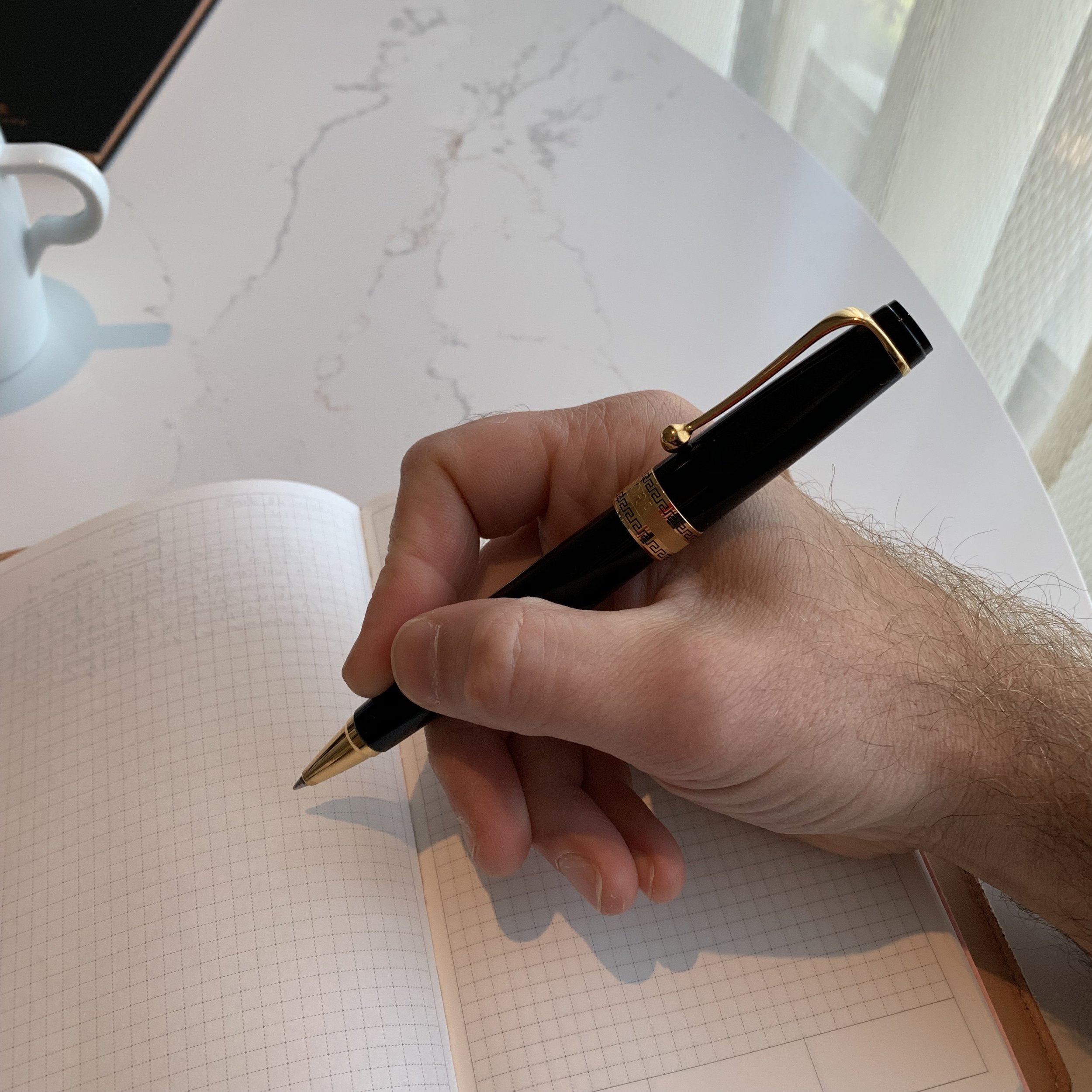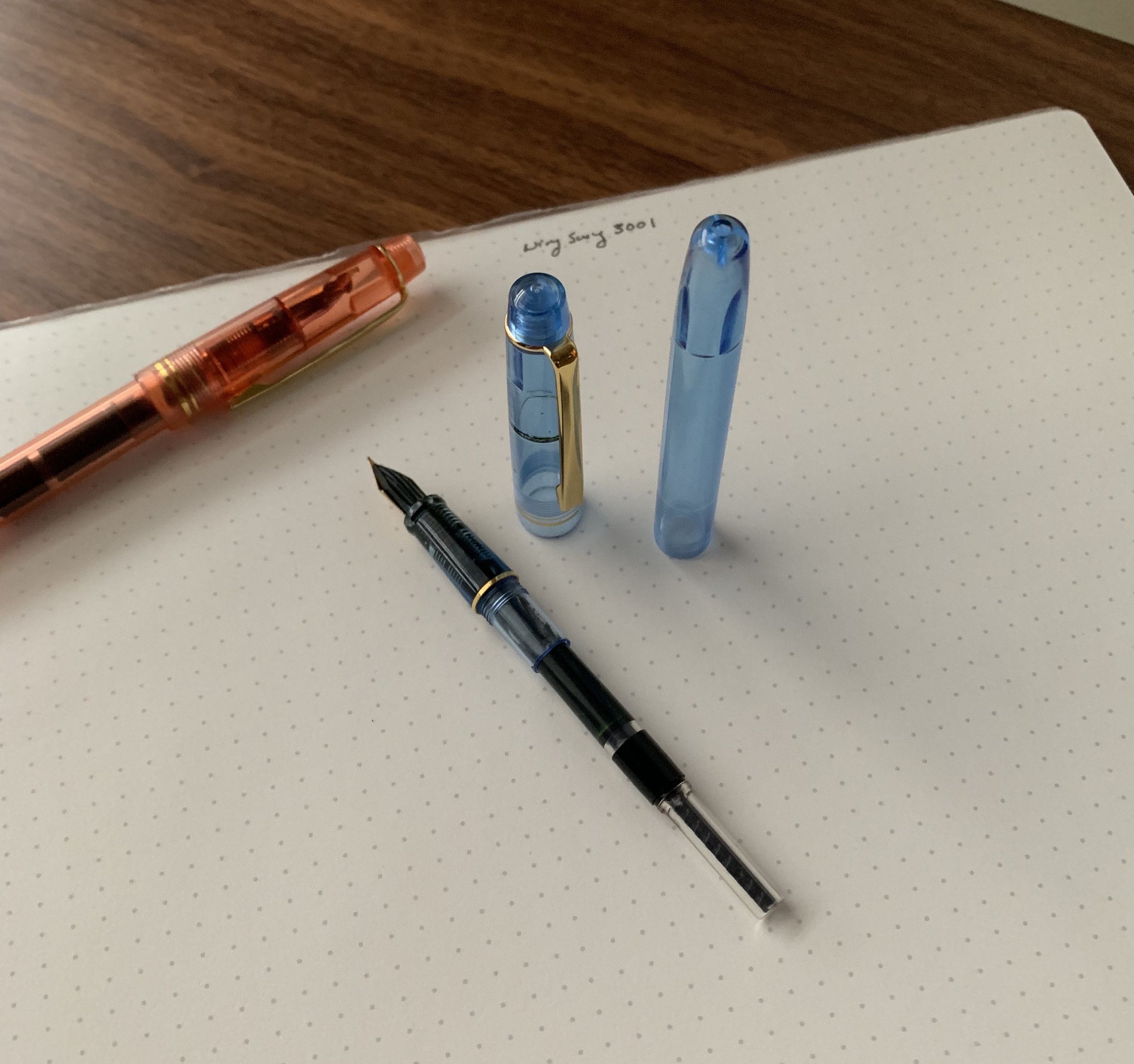I’ve been on a rollerball kick lately, especially at work. Rollerball pens are among the most versatile and practical pens out there for many reasons: they’re smooth writers, refills are easy to come by, and the ink is typically permanent. Rollerball cartridges use writing technology similar to a ballpoint (i.e., the ink flows from the cartridge to a metal ball, which “rolls” the ink onto the paper), but instead of oil-based ballpoint ink, Rollerballs use a liquid ink formulation. This assists with the “smoothness” factor, giving rollerball pens a feel closer to a fountain pen, but not as close as a fineliner or a felt-tip pen.
My “go-anywhere” rollerball pen: the Aurora Optima, shown here on top of my Nanami Paper Cafe Note B6 in Gfeller natural leather cover, which is starting to show some wear!
The other thing I appreciate about rollerball pens is the price - a “nice” rollerball pen will run you much less than the same model of fountain pen. Take, for example, the Aurora Optima. I’ve previously reviewed the Aurora Optima fountain pen, which sports a price $200 north of the rollerball version. (I’ve not managed to add a fountain pen version to my permanent collection yet, but perhaps that’s coming?) In the meantime, I found myself in the market for one or two understated, business-appropriate rollerball pens that I could take to business meetings, depositions, and even to court, so I could have a reliable writing instrument that is much less distracting than a fountain pen. The Optima ticks all of these boxes:
It’s understated. No non-pen-person is going to look twice at the black-with-gold-trim design, or feel that it’s overly showing or ostentatious (often an issue when you want to “blend in” at the back of a courtroom or board meeting). At the same time, you’ll notice that I used the term “understated,” and not “boring.” The Optima rollerball sports Aurora’s signature “Greek Key” design around the cap band that lends the pen character.
It features a solid refill. I enjoyed using the Aurora-branded refill that shipped with the pen, but I did end up swapping in a finer-tip Schneider Topball 850 .5mm refill, which doesn’t get nearly the amount of attention that it should. Because rollerball pens feature a sharper point which can dig down into the paper fibers, the liquid ink in the cartridges has a tendency to feather and bleed through the page, even on fountain pen-friendly stock such as Tomoe River and Rhodia. The stock Aurora refill and the Topball 850 both perform well in this regard - you might have a bit of showthrough but I experienced less bleeding than with Schmidt refills.
It’s comfortable and well-balanced. Here’s where I think the Aurora Optima truly shines as a rollerball. Many companies make their rollerball pens slimmer and lighter, presumably to mimic consumer preferences in the disposable pen market. The Optima, on the other hand, sticks to the same dimensions as the fountain pen, which strikes me as a larger version of my beloved Sailor Pro Gear. It’s an amazingly comfortable pen to write with - if you need to use a rollerball pen for longer writing sessions, consider splurging on an Aurora Optima.
The vintage-style barrel engraving adds a touch of class to this pen, imho.
Takeaways and Where to Buy
The Aurora Optima rollerball has served as a solid addition to my daily rotation alongside my Montblanc Classique Le Petit Prince rollerball, which I’ve been using as a fineliner. While the Optima doesn’t necessarily have the visual “wow” factor that turns heads, I wasn’t looking for that in this pen, which was intended to meet a specific need in my kit.
I purchased the pen pictured here from our site sponsor Pen Chalet. This black pen with gold trim is the “base model,” with prices starting at $265. The “Auroloide” versions are more expensive, starting at $445, and of course there are limited edition versions running as high as $800. Pen Chalet also carries the fountain pen versions of the Optima, with prices starting at $445 and running all the way north of $1200.
Disclaimer: This post contains affiliate links. I purchased this pen using affiliate store credit, which is one of the ways I manage to keep this blog going. Many thanks for your support!






